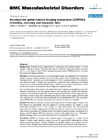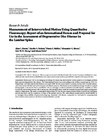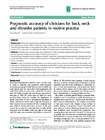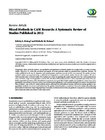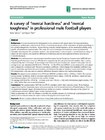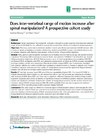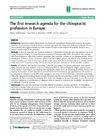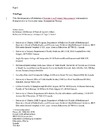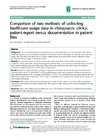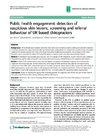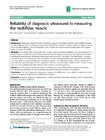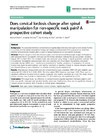Browsing AECC University College Research Collection by Issue Date
Now showing items 1-20 of 255
-
An objective spinal motion imaging assessment (OSMIA): reliability, accuracy and exposure data
(BMC Musculoskeletal Disorders, 2006)Background: Minimally-invasive measurement of continuous inter-vertebral motion in clinical settings is difficult to achieve. This paper describes the reliability, validity and radiation exposure levels in a new Objective ... -
Diagnosis and chiropractic treatment of infant headache based on behavioral presentation and physical findings: a retrospective series of 13 cases
(Journal of Manipulative and Physiological Therapeutics, 2009-10)Objective: This case series presents information on diagnosis and treatment of 13 cases of benign infant headache presenting to a chiropractic teaching clinic. Clinical Features: A retrospective search was performed for ... -
Measurement of intervertebral motion using quantitative fluoroscopy: report of an international forum and proposal for use in the assessment of degenerative disc disease in the lumbar spine
(Advances in Orthopedics, 2012)Quantitative fluoroscopy (QF) is an emerging technology for measuring intervertebral motion patterns to investigate problem back pain and degenerative disc disease. This International Forum was a networking event of three ... -
Chiropractic care of children from birth to adolescence and classification of reported conditions: an internet cross-sectional survey of 956 European chiropractors
(Journal of Manipulative and Physiological Therapeutics, 2012-06)Objective: Few studies have addressed the practice of chiropractic care of children in Europe. No systematic classification of conditions currently exists in chiropractic pediatrics. The objective of this study was to ... -
Mother-child bonding at 1 year; associations with symptoms of postnatal depression and bonding in the first few weeks
(Archives of Women's Mental Health, 2013)Some mothers experience neutral or negative feelings toward their new infant. This study examined the association between symptoms of postnatal depression and mother–infant bonding and the persistence of these feelings ... -
Prognostic accuracy of clinicians for back, neck and shoulder patients in routine practice
(Chiropractic and Manual Therapies, 2013)Background: Chronicity amongst musculoskeletal patients remains a considerable burden and predicting outcomes in these patients has proven difficult. Although a large number of studies have investigated a range of predictors ... -
Mixed methods in CAM research: a systematic review of studies published in 2012
(Evidence-Based Complementary and Alternative Medicine, 2013)Background: Mixed methods research uses qualitative and quantitative methods together in a single study or a series of related studies. Objectives: To review the prevalence and quality of mixed methods studies in complementary ... -
A survey of 'mental hardiness' and 'mental toughness' in professional male football players
(Chiropractic and Manual Therapies, 2014)Background: It is not uncommon for chiropractors to be associated with sports teams for injury prevention, treatment, or performance enhancement. There is increasing acceptance of the importance of sports psychology in the ... -
Moving back: The radiation dose received from lumbar spine quantitative fluoroscopy compared to lumbar spine radiographs with suggestions for dose reduction
(Radiography, 2014)Purpose: Quantitative fluoroscopy is an emerging technology for assessing continuous inter-vertebral motion in the lumbar spine, but information on radiation dose is not yet available. The purposes of this study were to ... -
Does inter-vertebral range of motion increase after spinal manipulation? A prospective cohort study
(Chiropractic and Manual Therapies, 2014)Background: Spinal manipulation for nonspecific neck pain is thought to work in part by improving inter-vertebral range of motion (IV-RoM), but it is difficult to measure this or determine whether it is related to clinical ... -
The first research agenda for the chiropractic profession in Europe
(Chiropractic and Manual Therapies, 2014)Background: Research involving chiropractors is evolving and expanding in Europe while resources are limited. Therefore, we considered it timely to initiate a research agenda for the chiropractic profession in Europe. The ... -
Proportional lumbar spine inter-vertebral motion patterns: a comparison of patients with chronic, non-specific low back pain and healthy controls
(2014)Introduction: Identifying biomechanical subgroups in chronic, non-specific low back pain (CNSLBP) populations from inter-vertebral displacements has proven elusive. Quantitative fluoroscopy (QF) has excellent repeatability ... -
Development and validation of providers’ and patients’ measurement instruments to evaluate adverse events after spinal manipulation therapy
(European Journal of Integrative Medicine, 2014)Introduction: Spinal manipulation therapy (SMT) is used throughout the world by chiropractors, osteopaths, physiotherapists and other manual therapists, yet there are no systematic data collection mechanisms in place to ... -
Comparison of two methods of collecting healthcare usage data in chiropractic clinics: patient-report versus documentation in patient files
(Chiropractic and Manual Therapies, 2014)The use of patient-reported questionnaires to collect information on costs associated with routine healthcare services, such as chiropractic, represents a less labour intensive alternative to retrieving these data from ... -
Public health engagement: detection of suspicious skin lesions, screening and referral behaviour of UK based chiropractors
(Chiropractic and Manual Therapies, 2015)Background: UK morbidity and mortality rates from skin cancer are increasing despite existing preventative strategies involving education and early detection. Manual therapists are ideally placed to support these goals ... -
Inspiring and motivating learners in Higher Education: The staff perspective
(Journal of Hospitality, Leisure, Sport and Tourism Education, 2015)There is currently a lack of research exploring strategies to inspire and motivate students. As a result, the current study explored the perceptions of academic staff regarding what being inspirational meant, its sources, ... -
Reliability of diagnostic ultrasound in measuring the multifidus muscle
(Chiropractic and Manual Therapies, 2015)Background: Ultrasound is frequently used to measure activity in the lumbar multifidus muscle (LMM). However previous reliability studies on diagnostic ultrasound and LMM have included a limited number of subjects and ... -
Preparing for performance: Strategies adopted across performance domains
(Sport Psychologist, 2015)The ability to prepare effectively to execute complex skills under pressure is crucial in a number of performance-focused professions. While there is emerging evidence of best practice little research has sought to compare ... -
Does cervical lordosis change after spinal manipulation for non-specific neck pain? A prospective cohort study
(Chiropractic and Manual Therapies, 2015)Background: The association between cervical lordosis (sagittal alignment) and neck pain is controversial. Further, it is unclear whether spinal manipulative therapy can change cervical lordosis. This study aimed to determine ... -
Tearing up the page: re-thinking the development of effective learning environments in higher education
(Innovations in Education and Teaching International, 2015)The development of effective learning environments in higher education (HE) appears to become increasingly prioritised by HE institutions. This approach reflects an increasingly ‘consumer’ focused student body, and HE ...
